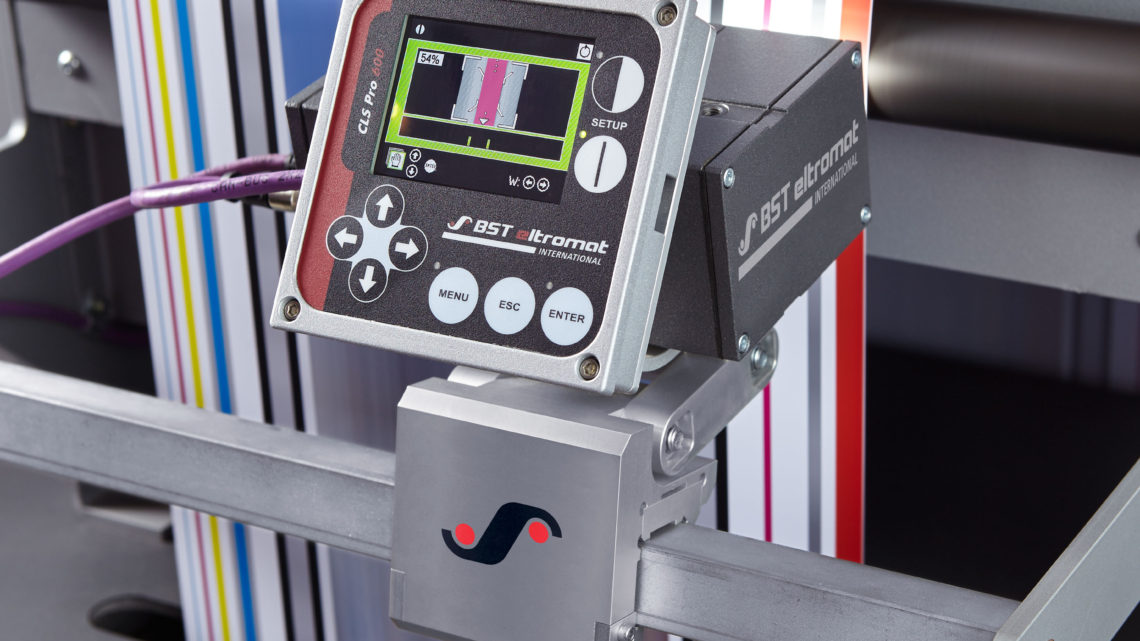
BST eltromat’s Web Guiding Systems permit Maximum Precision
March 26, 2019BST eltromat’s Web Guiding Systems permit Maximum Precision
Flexible packaging, printed electronics or advanced films – those are just a few examples of products that are manufactured by roll-to-roll processes and impose particularly high demands on the precision of web guiding. In this field, innovative solutions from BST eltromat International are capable of coping with any task.
Web guiding systems keep roller-guided material webs in the defined target positions. Even at the highest processing speeds, they guarantee precise infeed of packaging and label materials, etc. into the production system, and their passage through the individual process steps, all the way to straight-edge rewinding. In this way, the web guiding system ensures constant, perfect production quality. At the same time, faultless web guiding minimizes waste and machine downtimes.
The greater the demands on the precision of web guiding, the higher the requirements imposed on the key components used, i.e. on the sensors, the controllers and the actuators. Tried-and-tested solutions are available that meet even the toughest demands on the precision of web guiding. BST eltromat is one of the world’s leading suppliers in this field, offering a comprehensive portfolio of innovative, efficient and productive solutions that cover virtually all the demands of the market, including those on precision and the processing of very different materials.
BST eltromat has been specializing in quality assurance relating to the moving web since 1979, and has gathered comprehensive practical experience by installing over 100,000 systems around the world. The range of products offered on this basis gives customers a choice between eco versions, basic systems and high-end solutions – all of which are adapted to suit customer-specific needs, if necessary. Their particular user-friendliness is also a reason why so many companies opt for these solutions.
CompactGuide, the modular, upgradeable compact web guiding system in use at numerous companies, is an ideal solution for narrow material webs, for example. Six sizes, with web widths of up to 750 mm and for web tensions of up to 600 N, mean flexibility for different requirements – although small systems are used as a general rule, especially for producing printed electronics or advanced films, since they permit particularly precise control of web travel.
CompactGuide is characterized by a compact, modular design and an integrated controller, allowing it even to be installed in confined spaces. The plug-and-play design of the complete solution minimizes the installation and wiring effort. Flexibility is also offered by the detachable keyboard, which allows simple, intuitive operation from any point on the machine, and thus rapid, direct access to all control functions.
Which sensor or which camera, and when?
From ultrasonic sensors and optical sensors, line and reflection sensors, and also line scan cameras, all the way to wide-array sensors with particularly wide coverage – the BST eltromat product range includes sensors for virtually any demand on web guiding. And there is a steady stream of special solutions to cope with specific customer tasks.
Which sensors are used, and when, depends on the materials used, the applications, and the environmental conditions. Generally speaking, ultrasonic sensors are used with materials that generate dusty or fluffy deposits, with films having varying transparency, and with light-sensitive materials. Infrared sensors are typically selected for non-contact scanning of the edges of webs made of acoustically transmissive, non-transparent and thick materials. Contrast sensors detect light contrasts and scan web edges, print edges or printed lines. They ensure reliability in web guiding, even when dealing with critical materials, e.g. with reflective surfaces. They are also used in web center control and web width measurement.
The CCD CAM 100 and CLS Pro 600 digital sensors, in particular, open up a diverse range of options for meeting the toughest demands on precision, while offering maximum operating convenience. In the CCD CAM 100 high-performance color line scan camera, for instance, a microprocessor-controlled CCD chip, and different lenses for adapting the measuring range to the application, guarantee rapid and perfect detection of edges, elements and surfaces. Their high physical resolution of 10,000 pixels and up to 6-fold sub-pixel interpolation, in combination with a high scan rate of up to 10 kHz, form the ideal basis for precise edge and center control, as well as other inspection tasks. The camera is designed for quick and easy installation and commissioning. Among other things, the user prompting on the touch screen makes it easier to set all the necessary parameters.
The color sensors of the CLS Pro 600 digital line and contrast sensor offer precise, non-contact detection of solid lines, broken lines, print edges or web edges. The LED lighting makes for optimum light conditions at all times. Uncompromising reliability in web guiding is guaranteed, even at the highest web speeds and when handling critical materials, e.g. with reflective surfaces. The combination of high scan rate and high-resolution CCD color line chip ensures precise guiding of the webs, even when dealing with broken lines or contrasts. The CLS Pro 600 sensor provides such accurate control that the machines no longer have to be stopped to check the slitting accuracy when producing labels and printed electronics. Consequently, the machines can run at constantly high speeds.
The wide-array sensors from BST eltromat come into play if the web width fluctuates, or if formats are to be changed without having to mechanically reset and adjust the sensors. Offering intuitive operation and simple commissioning, they have measuring ranges of 30 mm to 467 mm and are optionally available as ultrasonic or infrared sensors. A special feature of these sensors is dynamic compensation for ambient influences. They measure not only the web edge, but also the environment, the sensor being simultaneously adjusted to cater to changing conditions, such as temperature fluctuations or dirt accumulating during operation.
Free choice of controllers, actuators and guiding devices, too
Sensors detect the actual positions of the webs and pass on this information to the controllers. The latter compare the target and actual values. In the event of deviations, they send correction signals to the actuators, which in turn move the guiding devices. The controllers from BST eltromat also come in different versions to meet virtually any requirement. All the controllers provide high-precision web guiding, but differ in terms of their range of functions and upgrade options, among other things. For example, the ekr CON 100 eco model stands out as the least-cost solution with intuitive operation, and can be flexibly used for basic web guiding applications. The range of functions of the ekr 500 digital basic system is tailored to the classical tasks of web guiding. The advanced ekrPro Com60 model is characterized by particular flexibility. One highlight of all controllers from BST eltromat is the speed and ease with which they can be put into service, thanks to their plug-and-play function.
Particularly when manufacturing technical materials that impose very high demands on the precision of web guiding, the actuators are the third key component for high accuracy. The BST eltromat portfolio comprises four sizes of electric motor drives with different powers, stroke lengths and regulating speeds. These actuators are available with automatic position detection. Without requiring additional sensor systems, this makes it possible to move to the center position, or implement stroke limitation to protect guiding devices against collisions, for example. In addition, the electric motor actuators from BST eltromat can be connected directly to the controllers by the plug-and-play principle. That permits quick, inexpensive installation – also when retrofitting equipment on existing systems.
Finally, BST eltromat offers guiding devices with various outputs, and of different sizes and types – such as rotating-frame and swivel-roll guides, as well as turning bars and controlled unwinders/rewinders. These guiding devices correct the position of the material web with great precision and virtually no delay. They are available for almost any web width and field of application. In addition, a host of different roll versions and coatings are available for handling various types of material. So, the guiding devices used in a particular instance ultimately depend on the materials to be processed, the web width, the web tension and the permissible stresses, and finally also on the space available on the printing presses.
Web guiding systems from BST eltromat are used in the production of packaging, paper products, films, laminates, printed electronics, tires, non-woven goods, and batteries, as well as in other industries involving web-oriented production processes. The three key components of these systems – the sensors/cameras, the controllers and the actuators – are developed and manufactured by the BST eltromat exclusively in Bielefeld, Germany, from where they are shipped around the globe. This ensures that the systems are of exactly identical quality all over the world.

